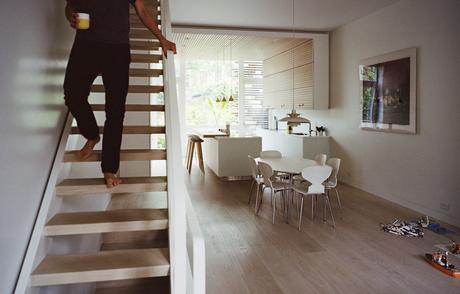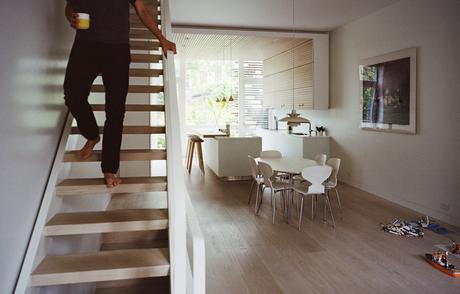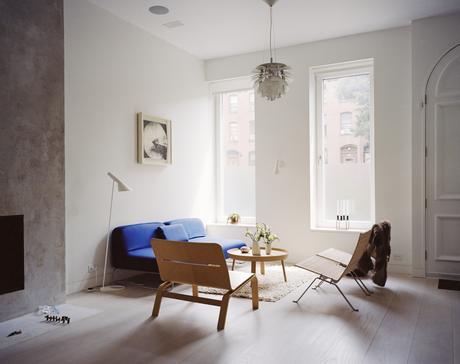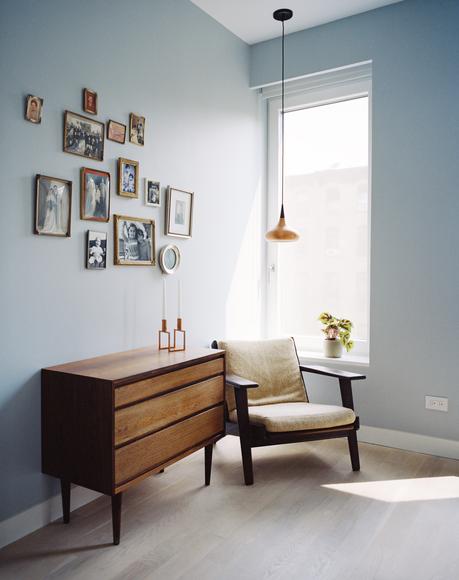
In undertaking a gut renovation of a town house in Brooklyn’s Park Slope neighborhood, husband and wife Jesper Meyer and Rimjhim Dey drew upon design elements from their respective roots in Denmark and India to create a home that’s wholly serene and accented with subtle pops of bright color. American white-oak planks, finished with lye and pigmented with whitening oil from Danish company Junckers, line the staircase and floors throughout; the dining area is furnished with Ant chairs by Arne Jacobsen and a PH50 pendant by Poul Henningsen for Louis Poulsen.
Project Park Slope Town House Architect Sarah JefferysUpon first glance, Rimjhim Dey and Jesper Meyer seem as opposite as any married couple can be. Jesper is just shy of six feet seven inches tall and comes from Denmark, seat of homespun, functional design. Rimjhim is almost a foot and a half shorter and was born in India, where a Nehru jacket is about as minimal as design ever gets. The meeting of cultures is so profound that when the couple married in a palace on the outskirts of Jaipur, India, in 1998, Rimjhim’s family considered it the most organized wedding they had ever attended; Jesper’s family remembered it as pure chaos. “Culture clash tends to happen a bit when our families meet,” says Rimjhim.
And yet the couple live—and even renovated a Brooklyn town house—together in harmony. Working with Sarah Jefferys, an architectural designer based in New York’s SoHo, they gutted a 3,000-square-foot brick building in Park Slope and rebuilt it into a tranquil setting for themselves and their two children, Rasmus, 13, and Rania, 9.

In undertaking a gut renovation of a town house in Brooklyn’s Park Slope neighborhood, husband and wife Jesper Meyer and Rimjhim Dey drew upon design elements from their respective roots in Denmark and India to create a home that’s wholly serene and accented with subtle pops of bright color. American white-oak planks, finished with lye and pigmented with whitening oil from Danish company Junckers, line the staircase and floors throughout; the dining area is furnished with Ant chairs by Arne Jacobsen and a PH50 pendant by Poul Henningsen for Louis Poulsen.
Entering the home with the couple’s heritages in mind, you may wonder whether a design battle had been waged and Scandinavia won. The interior is largely white, gray, and blond, the furnishings sparse and Danish modern. But in no way did Rimjhim—who founded and runs DEY., a PR firm that represents the Harvard Business School and the United Nations—capitulate to Jesper, a managing director at strategic consulting firm Accenture. On the contrary, her affection for Nordic design matches his own. “Rimjhim is a minimalist who wanted clean lines,” says Jesper.
When the couple began house shopping in 2011, they aspired to find a building in better condition than the ramshackle four-floor Victorian they ended up with. But after browsing expensive properties with interiors that didn’t suit their tastes, they were ready to rehabilitate a wreck—especially one that was conveniently located between two subway lines. Still, it took a leap of faith. “The house was so bad, it smelled of cat urine; the stairs were held up by wires,” Rimjhim recalls. “The children begged us not to buy it.”
At first they planned a basic renovation, but their ambitions swelled as they thought about creating a home that could take them through retirement age. Their friend Ken Levenson, an architect and leading advocate of passive houses, persuaded them of the cost-efficiency that would come from integrating
passive-house technology into a building ripped back to the studs. And Jefferys, whom they hired on another friend’s recommendation, was eager to help. “It made sense,” the designer says. “You’re touching every surface, anyway.”

The living room is furnished with rattan chairs from Fritz Hansen, a Muuto side table, an Artichoke pendant by Poul Henningsen for Louis Poulsen, and a blue Living Divani sofa, one of a few color-popping accents found throughout.
In the process, Rimjhim and Jesper soon discovered that building a passive house involved aesthetic and physical, as well as energy-saving, benefits. Most warming and cooling is done through energy recovery ventilators, so there are no air ducts snaking through dropped ceilings. The ceilings could be restored to their original heights (that would be ten feet seven and a half inches on the parlor floor), allowing greater clearance for Jesper and, increasingly, Rasmus. And because passive houses are well insulated and airtight for energy efficiency, they are notably quiet. On a hot, humid spring day, with the babble of Brooklyn left at the threshold, the house felt like a medieval church, cool and hushed.
There were three points, however, at which the couple’s passive house came into conflict with their dream house: First was the matter of a working fireplace. Rimjhim and Jesper strongly wanted one for the living room, though it would require direct venting to the outdoors. This transgression was ameliorated with a system of “makeup air”—in which a dedicated duct and electric heater supply warm air to the fireplace, which is otherwise too airtight to start fires.
Second was the issue of a ventilation hood—which vents through the roof—rather than a recirculating hood, which is a best-practice fixture of passive homes. But Rimjhim likes to cook, and the two insisted on a system that would help expel scents rather than leave them to circulate around the home.
Finally, they balked at trading their arched vintage front door for a contemporary, airtight one. Though the glass panes were replaced with solid wood, the door remains thermally leaky. “We wanted the outside to fit in with the neighborhood,” Jesper says.
Net zero the house may not be, but Jefferys believes that it is exceptionally attractive for its building type, thanks to Dey and Meyer’s acute design sensibility. Too often the efficiency demands of a passive house lead to “blocky standard constructions,” she says, but in this one, traditional features are mixed with visual surprises. The sober brick facade, for instance, contrasts powerfully with the glassy rear face of the building, which is partially covered in horizontal cedar slats that are at once a sculpture and a veil. (Rimjhim said that the idea was inspired by a photo she saw of a country house designed by the French architect Jean Nouvel.)

A touch of nostalgia marks the upstairs home office, furnished with several vintage pieces: a teak Danish dresser, a Hans Wegner armchair, and Jo Hammerborg’s 1962 Orient pendant, made from a copper shade with rosewood detailing.
At only 16 feet wide, the town house is served by the couple’s fondness for austerity and Arctic palettes, which give it a greater sense of spaciousness. Under-foot on the parlor floor are American white-oak planks that have been bleached with lye in the Scandinavian tradition and treated with pigmented oil supplied by
a Danish company called Junckers. In the kitchen, custom white-oak millwork alludes to the exterior sculpture, with slatted walls that rise to wrap part of the ceiling. Behind slide-away doors are generous spaces for appliances and tools.
Continuing the theme of minimalism, a spare, open staircase leads to the second floor, where a translucent glass wall creates a corridor extending from the master bedroom at one end to the master bath at the other. Dey and Meyer preferred the unfettered feeling of a windowed bathroom down the hall to the convenience of a windowless one closer to their room. The wall preserves their privacy; all that is visible from the other side are the silhouettes of their bodies, and evening light makes the glass glow.
If any motif predominates, it is light—as striking as the classic Danish lamps and candlesticks that decorate the rooms, and as subtle as the LED strips set in channels along the kitchen millwork and main staircase. Fixtures by midcentury designers—Poul Henningsen’s Artichoke lamp and Jo Hammerborg’s Orient pendant—complement venerated furnishings, including Arne Jacobsen dining chairs and a humble teak dresser in the second-floor home office that Meyer attests is of a traditional variety found in the home of every old Danish person.
Influences from India’s rich visual culture can also be seen throughout the place. You can find it in the green splash of the window shade in Rania’s third-floor bedroom—the fabric is by Marimekko, but vivid and evocative in hue—and in the glossy back-painted yellow glass panels in the garden-level bath. In the family room on that floor sits a teapot bearing the Cambridge University insignia. It belonged to Rimjhim’s paternal grandfather, who planned modern Jaipur and was the chief secretary of the state of Rajasthan. He passed his enlightened views about women’s equality down to her father, who then instilled them in her, she says.
Rimjhim’s attitude toward Scandinavian design isn’t acquiescence but an embrace. “The beauty of Danish culture is that even people not considered ‘posh’ still care about good design and believe it should be part of everyday life,” she explains. “It’s not something that divides the classes. That’s the opposite of India.”
- Log in or register to post comments
